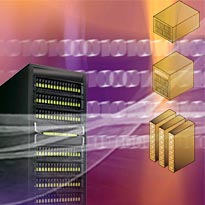Portal:Storage
From Wikibon
| Line 1: | Line 1: | ||
| + | <meta name="description" content="Portal page for all data storage information on wikibon" /> | ||
| + | <meta name="title" content="Storage Portal: Online Data Storage Management" /> | ||
| + | |||
__NOTOC__ | __NOTOC__ | ||
{| | {| | ||
| Line 21: | Line 24: | ||
</p> | </p> | ||
[[Storage virtualization design and deployment | read more...]] | [[Storage virtualization design and deployment | read more...]] | ||
| - | |} | + | |}[[Category:Business compliance]][[Category: NAS]][[Category: Storage Networks wikitips]][[Category: Storage and business compliance]][[Category: Storage consolidation]][[Category: Storage networks]][[Category: Wikitips]] |
Revision as of 20:13, 11 September 2009
WikitipThe NComputing L300 kit easily connects monitors to a host over EthernetDesktop virtualization in the enterprise often requires an army of IT professionals and a hefty price tag. But recent tests indicate that with the NComputing L300 Ethernet virtual desktop kit, you can have a virtual desktop infrastructure up and running in less than 15 minutes. End-User AdvantagesWith virtual desktops, each user expects a rich and unique experience, including well-performing applications and access to Internet and video. The L300 delivers such an experience. We tested the device using an underpowered Windows XP notebook as the host, with two L300 devices remotely connected. Primary office applications such as e-mail and word processing ran fine. We clicked through some websites and found that even with our underpowered host, most streaming media and Adobe Flash applications performed well. Without any moving parts, the 4.5-inch square L300 device is noiseless and can attach to the back of a monitor. It features USB mouse and keyboard connections, a speaker and microphone, and two additional USB 2.0 ports. The VGA port supports up to 1600x1200 (standard) and 1920x1080 (widescreen) pixel resolutions at 16- or 24-bit color with a 60-hertz refresh rate — just like any other video card — and the device consumes only 5 watts of power. Why It Works for ITEach kit comes with an NComputing L300 virtual desktop device and vSpace desktop virtualization software. You simply add one Windows XP/2003 host, a USB keyboard and mouse, a monitor and an Ethernet connection. Because the solution works over a 10/100 megabit-per-second network, there is no restriction on distance between the L300 device and the host computer, although they should be on the same LAN for best performance. The kit includes a bracket for mounting the L300 device to the back of an LCD monitor. Installation of vSpace is very straightforward. The software prompts you to download the latest version from NComputing, several virtual drivers are installed, and then you’re on your way. The L300 automatically scans the subnet for available hosts, and connects with just a click. No special training or modification of your applications is necessary. The vSpace software takes care of the multisessions, and users’ preferences and settings are stored in their own user directories on the PC. With a properly outfitted 32-bit host, you can connect up to 30 L300 devices. Imagine how easy it would be to apply software patches to just one host instead of 30 PCs. DisadvantagesAs you might expect from sharing a single host, the L300 isn’t for every application. It’s not recommended for 3D-intensive applications such as computer-aided design or movie-editing software. We had some trouble with high-quality, high-definition videos, but remember, we were on an underpowered system. Power users may notice a performance slowdown if they’re sharing a host with others who also do heavy number crunching or other processor-intensive tasks. But for most office workers, this shouldn’t be a problem. Action Item: Desktop virtualization is gaining in popularity. Recent surveys from the likes of ESG and IDC show that approximately one third of customers are deploying some form of desktop virtualization today and fewer than 10% indicate they have no interest in the technology. IT organizations need to understand the benefits and drawbacks of desktop virtualization and identify use cases that are a good strategic fit for the technology. Doing so will simplify maintenance and lower overall costs without degrading the end user experience. Footnotes: |
Featured Case StudyVirtualization Energizes Cal State UniversityJohn Charles is the CIO of California State University, East Bay (CSUEB) and Rich Avila is Director, Server & Network Operations. In late 2007 they were both looking down the barrel of a gun. The total amount of power being used in the data center was 67KVA. The maximum power from the current plant was 75kVA. PG&E had informed them that no more power could be delivered. They would be out of power in less than six months. A new data center was planned, but would not be available for two years. |
|
Featured How-To Note |
Storage Virtualization Design and DeploymentA main impediment to storage virtualization is the lack of multiple storage vendor (heterogeneous) support within available virtualization technologies. This inhibits deployment across a data center. The only practical approach is either to implement a single vendor solution across the whole of the data center (practical only for small and some medium size data centers) or to implement virtualization in one or more of the largest storage pools within a data center. | ||||



